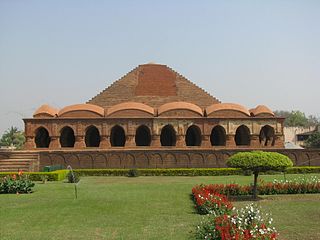
Bankura district is an administrative unit in the Indian state of West Bengal. It is part of Medinipur division—one of the five administrative divisions of West Bengal. Bankura district is surrounded by Purba Bardhaman district and Paschim Bardhaman district in the north, Purulia district in the west, Jhargram district and Paschim Medinipur district in the south, and some part of Hooghly district in the east. Damodar River flows in the northern part of Bankura district and separates it with the major part of Burdwan district. The district head quarter is located in Bankura town.

The music of West Bengal includes multiple indigenous musical genres such as Baul, Ramprasadi, Bishnupuri Classical, Kirtan, Shyama Sangeet, Rabindra Sangeet, Nazrul Geeti, Dwijendrageeti, Prabhat Samgiita, Agamani-Vijaya, Patua Sangeet, Gambhira, Bhatiali, Bhawaiya, Bengali Rock.

Chhau, also spelled Chhou, is a semi classical Indian dance with martial and folk traditions. It is found in three styles named after the location where they are performed, i.e. the Purulia Chhau of West Bengal, the Seraikella Chhau of Jharkhand and the Mayurbhanj Chhau of Odisha.
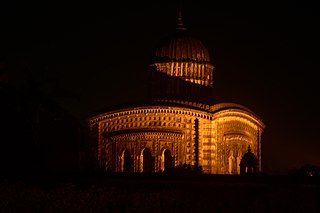
Bishnupur is a city and a municipality of Bankura district in the state of West Bengal, India. It is known for its terracotta temples built by the Malla rulers, historic Radha Krishna temples built during 1600–1800 CE and the Baluchari sarees.

Gurusaday Dutt was a civil servant, folklorist, and writer. He was the founder of the Bratachari Movement in the 1930s.

Bankura horse is the terracotta horse, produced in Panchmura village in Bankura district in the Indian state of West Bengal. It has been praised for “its elegant stance and unique abstraction of basic values.” Originally used for village rituals, it now adorns drawing rooms around the world as symbols of Indian folk-art. It is the logo of All India Handicrafts.
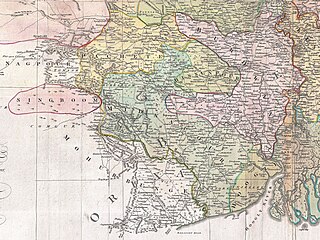
Mallabhum was the kingdom ruled by the Malla kings of Bishnupur, primarily in the present Bankura district in Indian state of West Bengal.

Patachitra or Pattachitra is a general term for traditional, cloth-based scroll painting, based in the eastern Indian states of Odisha, West Bengal and parts of Bangladesh. Patachitra artform is known for its intricate details as well as mythological narratives and folktales inscribed in it. Pattachitra is one of the ancient artworks of Odisha, originally created for ritual use and as souvenirs for pilgrims to Puri, as well as other temples in Odisha. Patachitras are a component of an ancient Bengali narrative art, originally serving as a visual device during the performance of a song.
Culture of Bankura district refers to the culture of Bankura district in the Indian state of West Bengal.
Manbhumi or Manbhumi Bengali is the local Bengali dialect spoken in the district of Purulia, and adjacent area of other districts of West Bengal and Jharkhand, previously Manbhum, in Eastern India. It is one of the Bengali dialects, having some influences of neighbouring dialects of Hindi and Odia in it.
Patrasayer is a village in the Patrasayer CD block in the Bishnupur subdivision of the Bankura district in the state of West Bengal, India.

Mask or Mukhosh of West Bengal, as it is known for has a mysterious history. Mostly it uses for the Mask Dance, the folk dance of West Bengal. The wearing of these masks is connected with early types of folklore and religion. There are various type of masks made up of clay, wood, sponge wood or shola, pith, paper, metal etc. Generally, half of these masks are made up of clay, pith and paper and wooden masks are very rare. Some of these masks come from the Tribal of West Bengal. Geographically, West Bengal comes well within this mask using culture zone. Masks in West Bengal is mostly used in folk dance. UNESCO selected The Rural Craft Hub of Bengal to showcase their artwork in Paris in 2015.
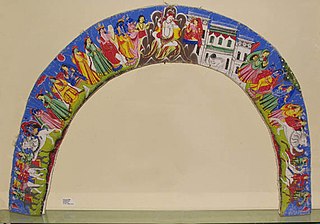
Chalchitra is a part of Bengal Patachitra. It referred to the Debi Chal or Durga chala, the background of the Durga Pratima or idol. Originally, these were used to give a proper proportion to the structure. This tradition is very ancient and is still maintained.
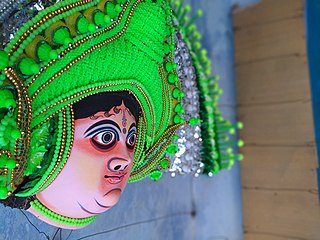
The Chhau mask is a traditional cultural heritage of Purulia in the Indian state of West Bengal. The Chhau mask of Purulia is registered on the List of Geographical Indications. As the basic difference of Purulia Chhau the mask is unique and traditional.

Patua Sangeet or Poter Gan is a cultural tradition of Bengal Patachitra. It is performed by a Patua. It is famous in the village part of West Bengal like Birbhum, Jhargram, Bardhaman and Murshidabad as a folk song of West Bengal.
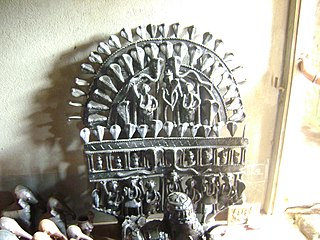
Manasa chali, or Manasa bari, is a type of idol of Debi Manasa made of Terracota in Panchmura, West Bengal, India. It typically features a small figure or a group of three figures in the middle with rows of snake hoods fanning out in a half moon shape. Chali or bari is Bengali for 'the shade of something'. Chali is referred to here as 'the shade of idol' or 'the besh of idol', like Chalchitra. These idols have two basic colors, reddish-yellow and black.

Charida is a village in the Baghmundi CD block in the Jhalda subdivision of the Purulia district in the state of West Bengal, India.
The National List of Intangible Cultural Heritage (ICH) of India is an attempt to recognize the diversity of Indian culture embedded in its intangible heritage. It aims to raise awareness about the various intangible cultural heritage elements from different states of India at national and international level and ensure their protection.

Swarna Chitrakar is a Patachitra artist from Pingla, a changemaker and a community leader.

Radh Bengal is a region in West Bengal also known as the Temple Town. This region consists of arrays of temples in varying sizes and devoted to different gods and goddess but the common thread unifying this group is that the temples are constructed in terracotta. The region consists of following districts Birbhum, Bankura, Burdwan, Purulia and parts of Murshidabad. The construction style originated in 16th century and lasted till the 19th century. This period is also referred as a golden age of temple in West Bengal. Reason for development of this construction technique was the rich red laterite soil of the region and lack of construction worthy stone. The skill of creating daily objects from like vessels, pottery, seal and toys evolved into a construction technique in the time of need. These temples are baked terracotta panels or bricks. This particular style spread outside the present day West Bengal as well, to Jharkhand, Bihar, Assam and Tripura.








































